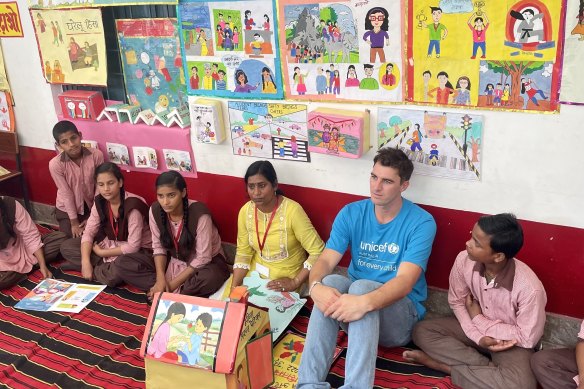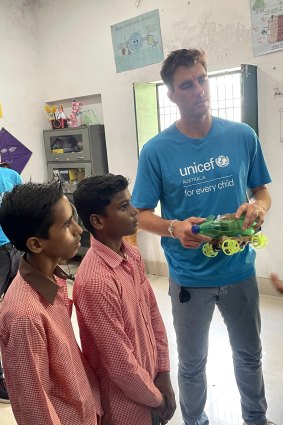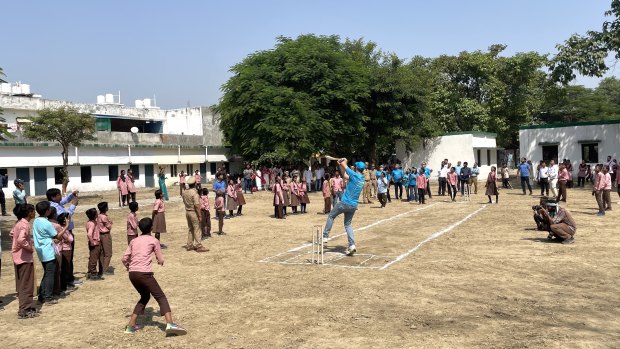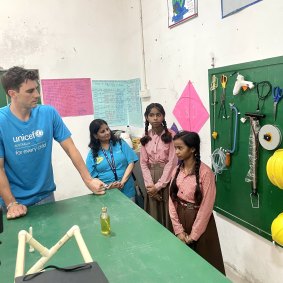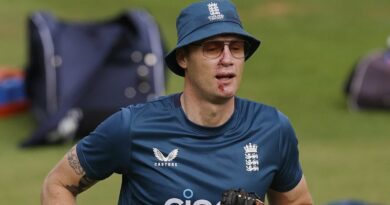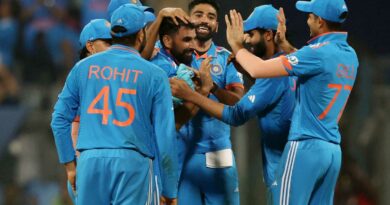In India, Pat Cummins goes back to school
Save articles for later
Add articles to your saved list and come back to them any time.
In Uttar Pradesh, India’s most populous state, there are more schoolchildren than there are people in Australia. On Tuesday, one of them, a tall 14-year-old girl, tells Australian cricket captain Pat Cummins about her life. “In our village,” she says, “boys can go out, girls cannot.”
As she speaks, Dr Amit Mehrotra, program head of UNICEF in Uttar Pradesh, adds context for this masthead. Twenty per cent of girls in Uttar Pradesh enter arranged marriages before they are 18, he says. “In so many cases, it’s children bearing children,” he adds.
Australian captain Pat Cummins at school in Lucknow.Credit: Greg Baum
Cummins has been at Composite School in Aurangabad on the outskirts of Lucknow for nearly two hours and has worked up a sweat as if in the final overs of a World Cup match, but his attention is unwavering. He says he believes in education in all its forms, which is why he takes to heart his role as a UNICEF ambassador.
His late mother, Maria, was a teacher and he’s already thinking about how education might deliver the sort of limitless opportunities for his two-year-old son Albie that cricket has for him. His scoop for the children at Aurangabad is that he loved woodwork at school. “In HSC, you don’t get marks for it, but I kept doing it because I loved it so much,” he says. “I still love doing a bit of DIY at home – but I’m terrible at it.”
Australian cricket captain Pat Cummins with two students at a school in Lucknow.Credit: Greg Baum
The Aurangabad school caters for 6- to 14-year-olds from the nearby suburbs and villages that are being swallowed up by Lucknow’s expansion. Some are from what Mehrotra calls “urban poor pockets’, whose parents work at menial jobs like house help and rickshaw-driving, typically earning less than $200 a month.
The school is running a program seeded by UNICEF and funded by the government. Called Learning By Doing, it began in 60 schools in Uttar Pradesh, but UNICEF is aiming to extend it to 1800 schools this year and eventually across the country and into the rest of South Asia.
It’s both practical and idealistic. At one level, it is meant to enthuse children who otherwise might find education too remote and abstract from their world. So it is that Cummins engages the children on a range of their projects: making kites, bikes, lenses, self-propelled model cars fashioned out of old plastic bottles, compost – and chocolate cake.
He takes a measuring tape out of a tool kit and explains how he uses one to lay out his run-up (24.5 metres, since you ask). This prompts one boy to ask how you become a fast bowler. “Long run-up, practice,” he replies, “and get a bit angry sometimes.”
The gender mix in this lab/workshop is not what you might expect. This is not accidental. “What UNICEF is trying to bring is gender role reversal,” explains Mehrotra. “Generally there are typical roles assigned to boys and girls. With Learning By Doing, we are shifting that narrative. We are getting boys to learn those things which generally the girls do, and we are getting girls to learn those traditional boys roles.”
Pat Cummins in his element at a school in Lucknow.Credit: Greg Baum
Across a dusty forecourt, the focus changes. Here, the girls’ horizons are being lengthened and broadened. Climate change, water conservation and energy conservation are on the syllabus. So too are ways to counter domestic violence, cultivate respect between genders and open doors shut to their parents. Two girls put on an arresting judo display for Cummins.
“The gender gap is still so great. But these girls eventually become women,” says Mehrotra. “They carry the legacy to the next generation. As they transition from girls to women, they’re more empowered.”
He says there was resistance from some men to the program, but it had faded faster than you might expect. And by normalising school attendance, Learning By Doing is having one simple effect: to delay and sometimes circumvent the risk of an early, involuntary and disempowered marriage. “Children must be allowed to have an adolescence,” he says.
By now, the Australian captain is sitting on the floor, hemmed in by fresh-faced, uniformed schoolchildren (and let’s be honest, a few teachers), a world away from his element and in it at the same time.
Pat Cummins draws a crowd at a school in Lucknow.Credit: Greg Baum
“It makes me grateful for the opportunities I’ve been given my whole life, especially around education,” he says. “But it’s inspiring to see kids here thinking about big problems they’re trying to solve, and armouring with the skills to go out and try to fix them.”
Cummins admits to what he calls a “selfish” agenda in his ambassador role. International cricket, he knows, can become an unhealthily enclosed and introspective occupation. “I love coming to these programs. It really takes you outside of the cricket bubble,” he says. “It’s always a great way to bring you down to earth pretty quickly.”
An IPL regular, Cummins is happy to further his acquaintance with India and its bewildering thousand faces. “There’s a culture here you can go about it two ways,” he says. “You can think it’s big and scary and overwhelming and you can hide in your hotel room, or you can embrace it. It’s so different to Australia, but I’ve really grown to love it.”
Pat Cummins with some budding engineers at a school in Lucknow.Credit: Greg Baum
In a previous cricket generation, former captain Steve Waugh was known for exploring beyond cricket’s four walls, once meeting Mother Teresa and establishing long-term links with an orphanage in Kolkata. He was celebrated for it. In this age, by some kind of reverse sanctimony, Cummins is sometimes mocked for his extracurricular work. He’s “woke”.
“Who cares? It means nothing,” he says. “Getting out, doing these programs, seeing UNICEF’s work, that’s nothing but an amazing thing for the world. I feel really lucky to be in this position.”
Mehrotra says there is a gain in Cummins’ appearance beyond the photo opportunity. “It gives a message to the government that there are a lot of good, willing people engaged with UNICEF,” he says. “It helps to raise trust in the UNICEF program. It helps to build the UNICEF brand, and this is important because, at the end of the day, it’s UNICEF’s brand value we take to the table to make suggestions.”
Cummins’ visit concludes on a powdery pitch in a grassless playground with a bit of, what else, cricket. The sportswriter in me cannot help but wonder what havoc India’s spinners would wreak here, but that’s a bubble thought. One girl catches the eye delivering medium pacers with a high action not unlike today’s celebrity guest. He nods approvingly (under UNICEF protocols, no child is named in this story).
Watching on, Mehrotra admits he was cheering against Cummins last Sunday night. “Of course, because I’m an Indian,” he says. “But after this, whenever Pat is playing, I’ll be supporting him.”
Most Viewed in Sport
From our partners
Source: Read Full Article

